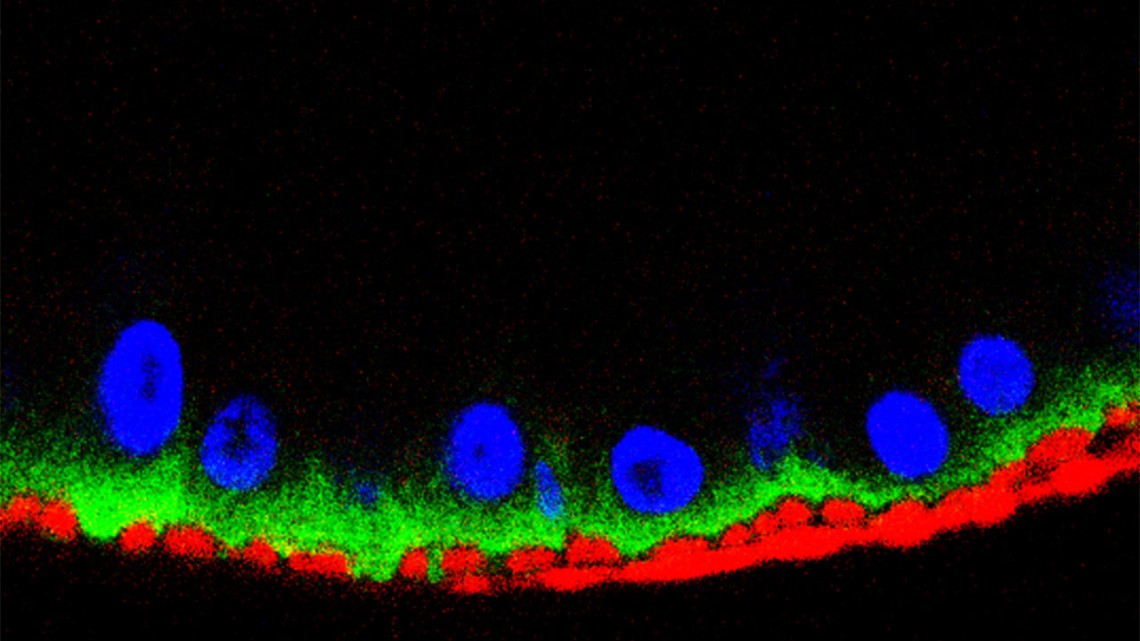
Viral spike proteins are transported to the basal (bottom) region of Drosophila midgut epithelial cells by host cell trafficking machinery. The image shows viral proteins (green), smooth muscle (red) and DNA (blue) in cell nuclei.
Viruses cross different tissues in insects to infect new hosts
By Krishna Ramanujan, Cornell Chronicle
A study in fruit flies reveals how viruses travel through an insect to infect a host with a bite, findings that advance fundamental understanding of the processes and machinery that underlie how insects, such as mosquitoes, act as viral disease vectors.
By understanding the interactions and genes involved in a virus’ movement through an insect, researchers may one day be able to block an insect’s ability to transmit viruses, for instance, by engineering a mosquito incapable of infecting a host and then releasing it to mate with and alter wild mosquitoes.
For mosquitoes to transmit disease viruses – such as dengue, zika, chikungunya and yellow fever – into a human or animal, the virus must be ingested, pass through epithelial cells in the midgut and into the insect’s circulatory system, and then exit the insect through salivary gland cells. Virus in the saliva would then infect another host when the mosquito bites.
Scientists have wondered how a virus can enter through one tissue type and exit through another, requiring different mechanisms.
“This knowledge is key to understanding how insects act as vectors for diseases, which relies on the ability of viruses to cross these critical tissue barriers,” said Nicolas Buchon, associate professor of entomology in the College of Agriculture and Life Sciences (CALS) and a co-senior author of the paper.
Though the processes described in this paper were studied in fruit flies, they are fundamental to all cells, from yeast to human cells.
“The study is important for understanding how viruses move through their hosts,” said co-senior author Gary Blissard, professor of virology at the Boyce Thompson Institute (BTI) on Cornell’s campus and an adjunct professor in CALS. “Viruses have evolved to use certain cellular pathways to successfully replicate and spread themselves from animal to animal. And that’s the basic reason that this is important to understand.”
The study, “Viral and Cellular Determinants of Polarized Trafficking of Viral Envelope Proteins From Insect-specific and Insect-vectored Viruses in Insect Midgut and Salivary Gland Cells,” was published Aug. 20 in the Journal of Virology.
While some viruses infect and kill insects, others have life cycles in which insects act as vectors to transmit infection to other hosts, including plants, humans and livestock. Insect pathogenic viruses replicate in the gut and spread to other tissues and kill the insect, while vectored viruses may replicate in many tissues but must cross the salivary glands to exit and infect a new host through an insect bite.
To cross cell membranes, viruses employ spike proteins which fit into receptors on host cells in order to penetrate and infect them. In the study, the researchers ran experiments with two spike proteins; one of them, GP64, came from a virus that only infects an insect host, while the other, VSV G, is a protein from a vectored virus. The team engineered fruit flies to express one or the other of these spike proteins. They then tracked the proteins in tissues within the fruit flies.
When viruses enter insects, they pass through the bottom (or basal) membrane of midgut epithelial cells to enter the insect’s circulatory system. But when a vectored virus infects the salivary gland cells, it must pass in the opposite direction, out of the top (or apical) membrane of salivary gland cells.
“The virus needs to move in the basal to apical direction in the salivary glands, because now it needs to move out of the insect,” Buchon said. “This movement requires different mechanisms, which are not yet fully understood.”
In the experiments, both spike proteins moved to the basal sides of the midgut cells, consistent with viral entry into the body. In salivary glands however, the two envelope proteins differed. GP64 could only move basally, which was expected for an insect pathogen. VSV G, on the other hand, was able to move apically in salivary gland cells, which would permit the virus to exit the insect and potentially infect a new host through an insect bite.
“In the future, it may be possible to create an insect where viral movement across the midgut barrier is inefficient or where the virus becomes trapped in the body cavity or salivary glands, preventing transmission,” Buchon suggested.
The study's co-first authors are Jeffrey Hodgson, a postdoctoral scientist at BTI and in the Department of Entomology, and Robin Chen, a doctoral student in the Department of Entomology. The research was funded by the National Science Foundation and National Institutes of Health.
Media Contact
Get Cornell news delivered right to your inbox.
Subscribe
